
Donald Trump was one of the most satirised presidents in American history, and now he’s gone. Do we have satirists to thank? Perhaps, but only in a small way. We misunderstand the nature and value of satire if we think it serves to oust political leaders – or prevent them from taking office. During the 2016 presidential elections, online media regularly praised American satirists like John Oliver and Samantha Bee for “murderslaying” or “annihilating” Donald Trump. Yet, all the satire in the world was not enough to really “Make Donald ‘Drumpf’ Again” – and keep him out of the White House in 2016. We should therefore not overstate satire’s impact on the 2020 elections.
The heroic conception of satire as a painful therapy for moral wickedness is rooted in magical thinking. Legend has it that the satirical verses of Archilochus, a poet from Archaic Greece, drove his fiancée and her father into suicide after they broke off an engagement. This notion of the satirist as deadly magician is still preserved in metaphorical claims that satire “annihilates” and, yes, even “murderslays” its political targets. However, given that satire has been around so long, and the current state of the world, the evidence is clearly stacked against the genre’s political efficacy.
Satirists are often the first to acknowledge their political limits. As Jon Stewart told David Frost, “if [satire’s] purpose was social change, we’re not picking a very effective avenue.” Satires are really designed for something other than changing the world. Nonetheless insisting on the contrary is equivalent to stating that hammers are the most efficient tools to fix televisions. That’s not what they are made for, and by overlooking their real purpose, we risk wasting our time, or worse, causing irreversible damage.
Satires are made to critique and entertain. Critique constitutes moral opposition against social wrongness, while entertainment involves pleasurable aesthetic diversion. Satire’s central purposes typically interact fruitfully. Take John Oliver’s motto to “Make Donald ‘Drumpf’ Again”, which alludes both to Trump’s infamous 2016 campaign slogan and the less well-known German roots of his family name (which used to be “Drumpf” before his grandfather immigrated to the US from Germany). Oliver’s satirical joke is both funny and insightful because it succinctly captures the phoniness of the Trump brand alongside his hypocrisy about immigration policies.
Nevertheless, satire’s purposes to critique and entertain ultimately also pull in different directions. As Oliver explains, what “we’re most proud of is not those long stories [about socio-political issues] but the spectacle.” Although satirists are in the moral business of critique, they also spend considerable resources on entertainment for the sake of it – as when Oliver lit up a spectacular firework display to outdo the shabby production values in a video by a corrupt FIFA executive. Devoting precious resources to such spectacle confirms Stewart’s point that satire is not designed as the most efficient avenue for social change. Hence, when comedian Dick Gregory became increasingly committed to civil rights politics, he abandoned satire for more direct political activism, like hunger strikes.
Satire’s moral purpose to critique and its aesthetic purpose to entertain are in tension with each other. Critique demands political action in opposition to social injustice, while entertainment is what we do “for fun”. Therefore, liking satire is a bit like eating ice cream at a protest march against climate change; it feels inappropriately indulgent, because we should really be angry (and our leisurely indulgencies may well seem part of the problem). As a result, our engagement with satire is often deeply ambiguous.
This ambiguity is captured by Margaret Atwood, who is puzzled by fans’ responses to The Handmaid’s Tale. In Atwood’s satire of patriarchal misogyny, a class of fertile women – the handmaids – serve as concubines and surrogate mothers to a ruling class of puritan hardliners. Once a month, every handmaid is forced to endure an aberrant mating ritual with her commander, alongside his infertile wife, until she bears him a child – an act of polygamous rape purportedly justified by Biblical principles. Much to Atwood’s bewilderment, she notes that “[r]evellers dress up as Handmaids on Hallowe’en and also for protest marches – these two uses of its costumes mirroring its doubleness. Is it entertainment or dire political prophecy? Can it be both?”
Some have said no. Aesthetes have followed Wyndham Lewis in identifying all satire as “non-moral”. Moralists have gone even further and consider satire an immoral breeding ground for cynicism. According to Tom Lehrer – himself once a satirist – satire leaves audiences “[s]atisfied rather than angry, which is what they should be.” Moralists like Lehrer worry that satire ultimately upholds the status quo by purging the negative emotions required to sustain political action – and therefore serves as a safety valve that stimulates political apathy.
Satire’s reception is clearly ambiguous. The genre is at once hailed for slaying political opponents, enjoyed for its amoral aestheticism, and mistrusted as a frivolous pastime which cultivates cynicism. However, none of these perspectives accurately frame the nature of satire. At most, they signal that the genre’s central purpose to critique and entertain is ambiguous. Yet, they fail to clarify this ambiguity’s true significance, which speaks to a fundamental tension in our lives between the care for others and care of self.
Satirical cartoonist Dan Perkins, aka Tom Tomorrow, explains that satire is “a two-pronged assault. There are lots of things in this world you need to be outraged about, but outrage unchecked by laughter will eat you up inside. You need to laugh. That’s where we come in.” The moral care for others demands that we are angry about social injustice, so we are motivated to take political action. Yet, prudent care for our own wellbeing equally demands that we sometimes step back from critique. We cannot be angry at the world all the time, otherwise we’ll likely become depressed.
Critique is indispensable but also has its limits. We do not have unlimited resources to sustain political action, which is itself often limited in achieving actual social change. The limits of critique may seem like reason to devote ourselves unabatedly to improving things. However, for most people, unabated devotion to critique sets expectations which are simply unattainable and – if nonetheless pursued – cause the psychological suffering of incessant guilt and neurotic perfectionism. We are neither morally perfect nor politically omnipotent. Therefore, we must accept the difficult truth that there is suffering which we cannot alleviate, and to which we may even be complicit.
This existential conflict between care for others and care of self was a central theme for Nietzsche. In his introduction to The Gay Science, Bernard Williams explains that the hyper-sensitive Nietzsche refused to forget how the world’s glories and achievements were also intertwined with its horrors. Due to globalised information technology, we are now all very much in Nietzsche’s situation. In a 24-hour news cycle, nobody can honestly ignore the horrors of the world or plead ignorance about the consequences of their actions. Yet, Williams also explains that anyone who constantly pondered these horrors would be crushed by their weight.
Therefore, according to Williams, Nietzsche’s challenge is how we can make truth bearable. His own solution, in The Will to Power, is that “[w]e have art in order not to die of the truth.” Aesthetic experience provides solace for suffering that we cannot alleviate and to which we may even be complicit. Satirists have understood this message well. As satirical cartoonist Jen Sorensen puts it, “[m]any cartoons [of mine] are not overtly political. One can only write so many strips about torture before one needs to lighten up with a riff on Gucci flipflops.”
Other philosophers have similarly shared Nietzsche’s intuition about the solace of aesthetic experience (which does not just characterise art but also activities like appreciating nature, food, or sports). In A Treatise of Human Nature, David Hume explains how his struggle with insoluble conundrums introduces a “philosophical melancholy and delirium” that “reason is incapable of dispelling.” Fortunately, Hume knows just the trick. He dines or plays a game of backgammon – and “after three or four hours’ amusement”, he hardly remembers what his despair was all about.
Hume’s aesthetic engrossment in “amusement” (or entertainment) is similar to what positive psychologist Mihaly Csikszentmihalyi calls “flow”. When we experience flow, we lose all sense of time as we enjoy an activity for its own sake, because its challenge perfectly matches our skills. Entertainment media typically aim to stimulate flow. Prestige dramas like Game of Thrones introduce complex plotlines that keep us hooked (without confusing us), while casual games like Candy Crush increase in difficulty to match our improved skills as we progress through the levels.
Hume is wise to resort to entertainment instead of more demanding and challenging aesthetic activities to dispel his existential despair. After all that philosophical contemplation, his cognitive resources are clearly already depleted. Therefore, if Hume had access to all the art in the world, it would be best to stay clear from David Foster Wallace’s Infinite Jest (with its 388 endnotes that sometimes include further footnotes). Similarly, in his despair, he does not need further emotional disturbance. So, Hamlet is off the table as well – as is Joshua Oppenheimer’s The Act of Killing, a fascinating but disturbing documentary about the Indonesian genocide.
Instead, to soothe his existential despair, Hume is better off playing a few levels of Candy Crush to “swipe the stress away”. Entertainment introduces pleasurable challenges that produce flow, which not only offers pleasurable diversion, but combats philosophical melancholy by instilling life with meaning in the moment. This is why satirists devote so many resources to entertainment, because it provides solace from the limits of critique and helps us deal with the difficult truth that there is suffering which we cannot alleviate and to which we may even be complicit.
Nonetheless, some philosophers worry that aesthetic engrossment in entertainment causes moral apathy. In his Pensées, Blaise Pascal describes how a man, “so distressed at the death of his wife and his only son” momentarily became “free from all painful and disquieting thoughts” simply because “a ball has been served him, and he must return it to his companion.” For Pascal, such diversion (divertissement) does not offer valuable coping but distracts from spiritual growth as we continuously lose ourselves in pleasurable diversion.
Pascal does have a point. Candy Crush addiction is real. Some people are reported to play for up to 18 hours a day, which prevents sustained philosophical reflection or political action – and, of course, it’s also unhealthy. However, if we cannot divert ourselves from the world’s horrors, we may end up like Pascal himself, who was unable to cope with the premonition of a post-metaphysical world at the dawn of modernity and sought refuge in Jansenist Catholicism at the Port-Royal Abbey.
We need to strike a balance, which is why satire’s central combination of critique and entertainment is so significant. Satire is more complex than Candy Crush. It does not just provide pleasurable aesthetic engrossment, but it also critiques social wrongness. Yet, critique has its limits. We do not have the resources for unabated critique, and all the political action in the world is sometimes insufficient to curb social injustice and terminate suffering. The difficult truth is that insoluble suffering exists, which makes the world seem absurd and devoid of meaning. Here, entertainment offers solace by cultivating pleasurable aesthetic engrossment that is intrinsically meaningful.
This complex interaction between critique and entertainment is what Dan Perkins calls satire’s “two-pronged assault.” Perkins also explains that “[y]ou have to want to save the world in order to get up every day and do this work [satire], but in order to maintain your sanity, you simultaneously have to understand that you’re just not going to.” The attempt to cure a world that is sick beyond full recovery is indeed an absurd Sisyphean labour. Satirists cope with this insoluble absurdity by combining critique and entertainment in a complex negotiation between the Scylla of moral apathy and the Charybdis of mental ill health.
The need to cope with the limits of critique explains why Jon Stewart dismisses satire as the most efficient means for social change. Satirists do not spend all their resources on critique, but also develop aesthetic strategies to cope with its limits. Hence, satires are really designed to negotiate the existential conflict between care for others and care of self. They are artefacts through which satirists and audiences strike a balance between raging at the world and sustaining good mental health. In this respect, Stewart explains that satire affords “a view of the world that is informed by absurdity or humor” and therefore “still allows you to feel like you are connected to it”.
According to Stewart, “the real outcome of satire is typically catharsis” and he likens its emotional impact to “a release valve”. However, this metaphor inaccurately captures how satire contributes to coping and supports a mistaken scepticism about its political impact. According to the safety valve metaphor, satire purges negative emotions (like anger or frustration) that would otherwise contribute to political action. Yet, aesthetic engrossment in entertainment does not involve purging negative emotions. Instead, being entertained involves experiencing pleasurable feelings of fun and enjoyment.
Susan Folkman, a contemporary psychologist, claims that positive emotions contribute to coping in a complex way. The need for coping arises in contexts where we appraise certain demands as too taxing for our resources – like trying to eradicate all the suffering in the world. If we cannot resolve such a conflict, we become stuck in a vicious cycle of chronic stress and associated mental ill health. Positive emotions contribute to the coping process by distancing us from our worries and introducing meaningful moments in life – even in dire circumstances. Moreover, experiencing positive emotions also lets us take a breather, which contributes to further coping by restoring and replenishing resources for addressing the underlying issue.
Therefore, saying that satires are artefacts which help us to cope with a sick world – without curing it – does not entail that the genre stimulates moral apathy or acquiescence in the status quo. The positive emotions associated with entertainment not only offer solace from the absurdity of insoluble suffering, but also provide respite that allows us to recharge the resources that we need to sustain political action and alleviate suffering where we can. This complex coping process underpins much of our engagement with satire.
Consider the Trump Baby blimp, a 20ft orange balloon with bouffant hair that represents the former president as an angry, diaper-wearing baby, who clutches his mobile phone as if it were a rattle. During his presidency, protesters first flew the blimp over Parliament Square in London when Trump visited the UK in 2018. It did not prevent him from revisiting the following year, when the blimp flew again, alongside a smaller version, which was stabbed with scissors by a pro-Trump activist. The satirical blimp clearly got under the skin of some Trump supporters – and rumour has it he was not too happy about it himself – but it clearly did not metaphorically “destroy” or “cure” Trumpian politics.
Still, Trump Baby served as a satirical totem for protesters all over the world – from Argentina to the US. Moreover, the protest group behind Trump Baby only committed to flying their blimp during the President’s 2019 UK visit after raising £30,000 for grass roots organisations that actively counteracted his policies. So, satire is not without political power, but its impact is mostly indirect (by sustaining more direct political action) and should not be overestimated (the Baby blimp did not magically oust Trump from office).
Still, it is fair to say that satirical protest against Trump is a form of political action which, among a host of other factors, was relevant to the outcome of the recent presidential elections (although trying to establish causal influence is really impossible). But we need to first acknowledge how satire serves to cope with a political world that is sick beyond full recovery. Trump may be gone, for now, but his brand of political populism remains a threat to social justice and democracy. And that’s not to mention the socio-economic devastation caused by the pandemic, or the existential threat of climate change. There is still lots to cope with, including our own limitations. Fortunately, we have satire to help us cope with a world that is sick beyond full recovery.
Dieter Declercq is lecturer in film and media studies at the University of Kent, where he investigates the value of popular media to our wellbeing. In his new book, Satire, Comedy, and Mental Health (Emerald 2021), he argues that we need satire to deal with a sick world that we cannot fully heal.

